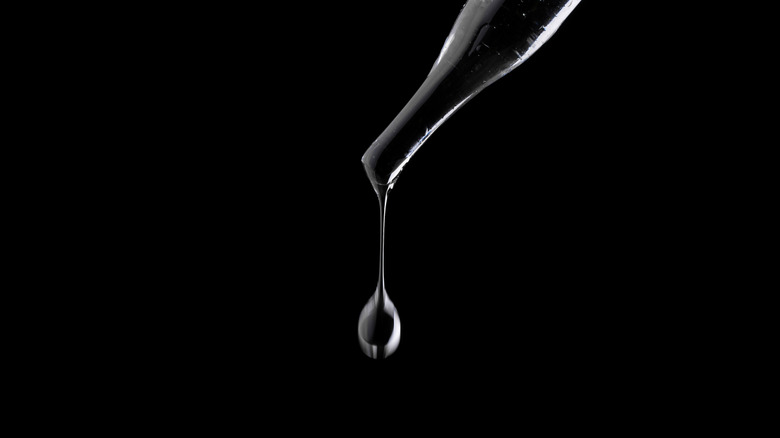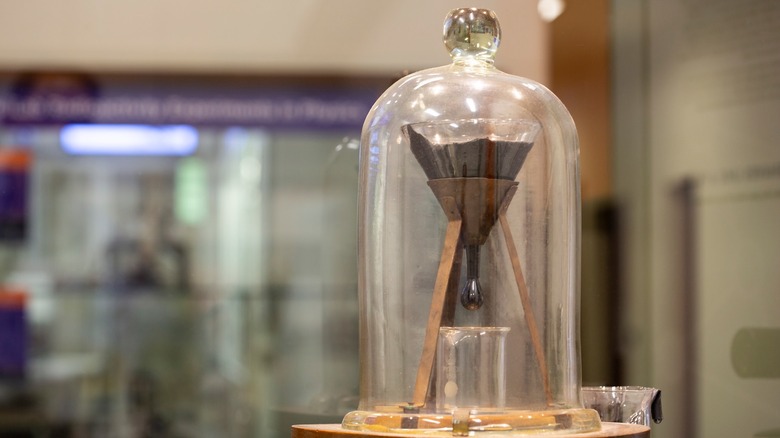The Slowest Moving Liquid On The Planet
If something is taking ages to get done, you might say it's going "slower than molasses in January," but there is a different liquid out there that flows so slowly, it makes molasses look like Usain Bolt. This liquid is called pitch, a residue left over from the distillation of tar from coal, petroleum, and wood. Pitch has the highest viscosity of a fluid known to humankind, being 100 billion times more viscous than water. It is so thick that upon initial observation, it appears to be solid, even breaking under the force of a hammer.
It was long assumed that pitch was a solid, but in 1927, a physicist at Australia's University of Queensland named Thomas Parnell came up with an experiment to prove pitch's liquid nature and viscosity. First, he put on his blacksmith hat and heated a sample of pitch all the way to a molten state. He then poured the pitch into a glass funnel and let it cool. So hot had the pitch become that it took three years for the sample to finally settle at room temperature.
Once the pitch had fully cooled, Parnell cut open the bottom of the funnel so that the pitch could begin dripping out into a collection beaker. He had essentially constructed an hourglass, but filled with pitch instead of sand. It's now been nearly a century since Parnell opened that funnel, but his sample of pitch is still dripping, earning it the Guinness World Record for the longest-running lab experiment in the world.
Parnell's pitch drop experiment
As of the writing of this article, it has been 95 years since the pitch drop experiment began, and in all that time, only nine drops have fallen from the funnel. To put the rate of flow into perspective, Australia, where the experiment is based, is gradually moving northward due to continental drift at a rate of about 70 millimeters per year ... the pitch drop is going 10 times slower than that. Three different professors have overseen the experiment, with Thomas Parnell only living to see the first two drops. After his death, fellow physics professor John Mainstone took custody of the pitch drop experiment. By the time he died in 2013, eight drops had fallen in total, and responsibility for the pitch drop then passed to professor Andrew White.
The time between drops has typically been just shy of a decade. The first seven drops all fell in intervals of seven to nine years. However, the eighth drop sparked renewed interest in the experiment, as it took over 12 years to fall. Scientists weren't sure why, but have hypothesized that the cooler air caused by the installation of a new HVAC system in the university could have increased the pitch's viscosity. Complications arose with the ninth drop, when it landed on top of the eighth drop below, forcing White to replace the collection beaker and prematurely cutting the drop. That was back in 2014, and 11 years later, the 10th drop is yet to fall.
There are other pitch drop experiments
The University of Queensland pitch drop is one of the most famous experiments in science, but there are actually a number of other pitch drops in progress, which have returned fascinating results of their own. Of particular note is a pitch drop experiment set up in 1944 at Trinity College in Dublin, Ireland. Although not quite as old as Thomas Parnell's experiment, the Trinity College version has produced something its older counterpart has yet to do: footage of the moment a drop of pitch falls. For decades, researchers watched to see the precise instant that a drop separates from the mass in the funnel above, but nobody actually saw it (John Mainstone famously missed the seventh drop because he had gotten up to get a drink). The 2010s brought round-the-clock webcam surveillance, and in 2013, Trinity finally got the footage.
There are even pitch drops that are actually older than the University of Queensland experiments. The oldest, housed in the Royal Scottish Museum in Edinburgh, was set up in 1902. Of the two drops known to have fallen, one only came because the experiment was being moved between locations. Another pitch drop experiment at Aberystwyth University in Wales dates back to 1914, but the pitch used in this case is so thick, that in over 110 years, not a single drop has fallen. Although older than the University of Queensland experiment, poor record keeping and a lack of results likely cost these two versions a world record title.


